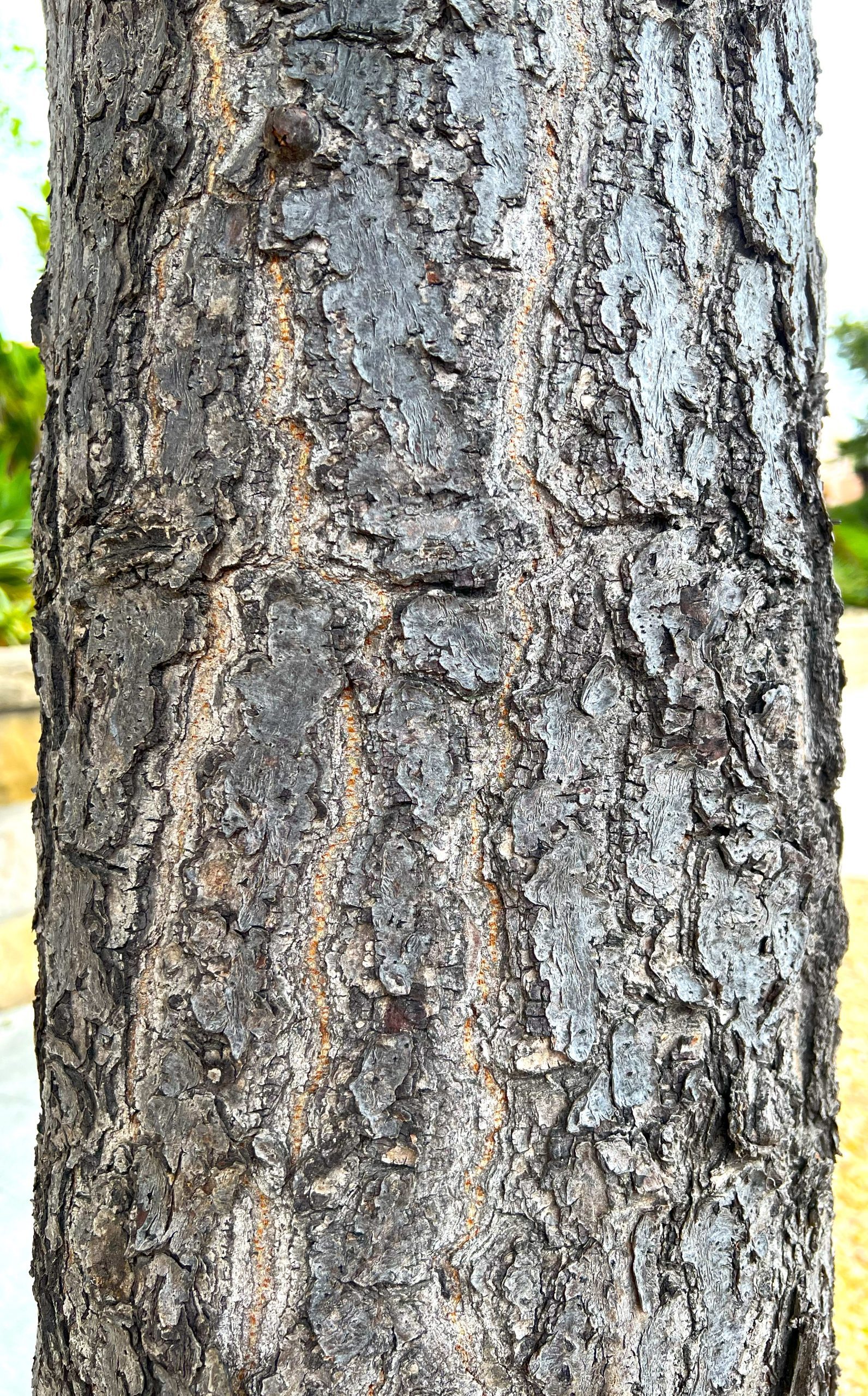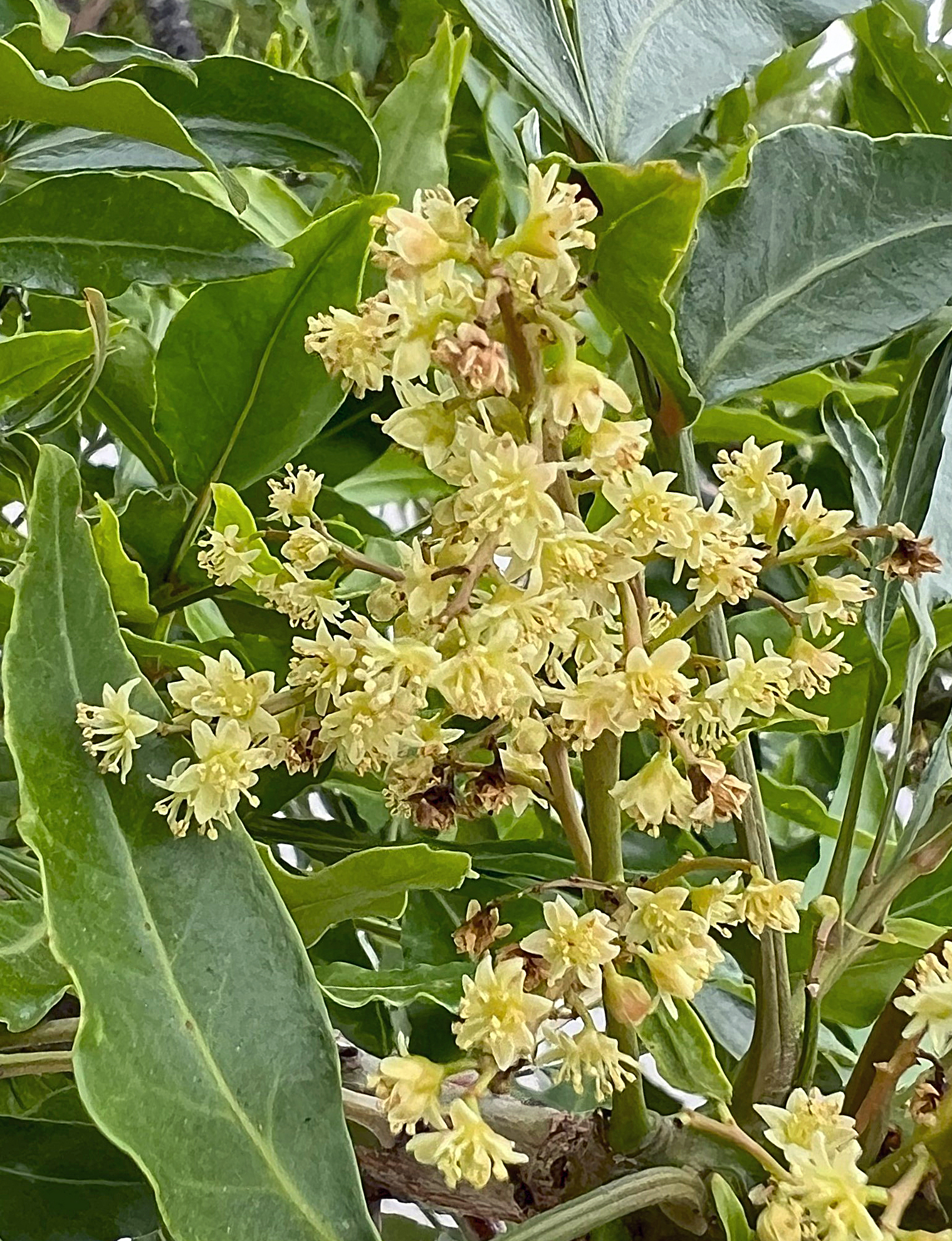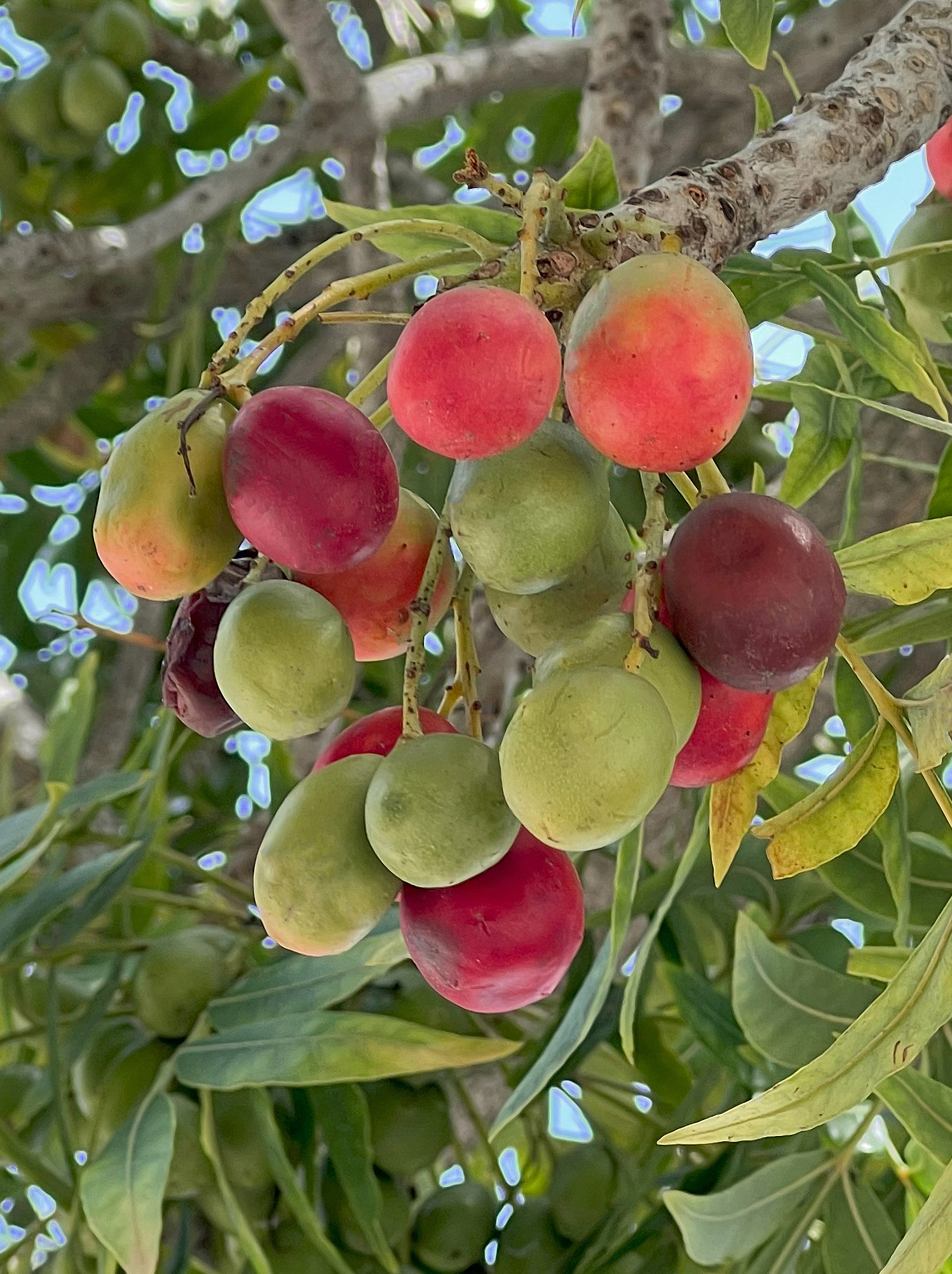Harpephyllum caffrum
The African Wild Plum is a tidy, ornamental, small- to medium-sized, broadleaf evergreen tree that has regularly been planted in the Santa Barbara area, where it has been appreciated for both its pleasing appearance and its suitability for our Mediterranean climate.
African Wild Plum carries a densely rounded crown atop a straight main trunk. Its limbs curve distinctively upward. All year long, it remains attractive, due to the lush and glossy leaves, which are concentrated near the ends of its branches.
In our community, it is considered a slow-growing tree, developing at the rate of 1- to 2-feet a year, to reach a height of 25- to 30-feet, with an equal or greater branch spread.
The bark varies from a reddish- to a whitish-brown. When young, it has noticeably raised lenticles (pores that allow gas exchange between the atmosphere and the internal tissues). With age, the bark darkens to a gray and develops shallow fissures scattered in a random pattern over the trunk, with cinnamon-brown showing in the cracks.

The pinnately compound leaves (6- to 12-inches long) are comprised of 8 to 16 leaflets. The terminal leaflet is lance-shaped; the lateral leaflets are strongly sickle-shaped and often winged between the upper leaflets. Each mature leaflet (1-inch to 2-inches long and ½- to 1-inch wide) is a dark green on top and a dull green underneath. When new, the leaves are a light green; old leaves often turn a bright red before dropping off. When crushed, the leaves exude the subtle scent of turpentine.
In April to June, an abundance of small (1/8-inch diameter), 4- to 5-petaled, creamy to greenish-yellow-colored flowers emerge on panicles (loosely branching clusters) that sprout from the axils (the areas of the upper angle formed between the leaf stalks and their stems). The flowers can be quite inconspicuous, because they are often nestled in the tight foliage at the ends of branches. Close observation is often required to see them at all.
The Wild African Plum is generally “dioecious”, meaning that any individual tree will have only male flowers (which produce pollen) or only female flowers (which produce seeds). However, occasionally, the flowers can be “perfect”, meaning that each flower bears both stamens (male flower parts) and pistils (female flower parts). Flowers are pollinated primarily by bees, which are eager for the generous amounts of pollen and nectar provided.

Once pollinated, flowers produce dangling clusters of oblong fruits (up to 1-inch long and ½-inch wide) called “drupes” (a single seed inside a fleshy coating). The thin outer layer of fruit flesh surrounds a pitted shell that contains a flattened, reniform (kidney-shaped), seed. The flesh is edible but tastes somewhat sour, much like a tart cherry. While the flesh is too sparse to make a satisfying snack, it can be used to make tasty jams and jellies, as well as light wines.
From May into July, the fruit ripens a beautiful bright red, creating a striking contrast against the dark green foliage and a colorful display in the landscape. The ripe fruit will be gobbled by birds and squirrels.

The African Wild Plum is endemic to the coastal forests of eastern South Africa – extending northward to Mozambique and Zimbabwe. Growing mostly in riparian areas (wetlands adjacent to rivers and streams), it is one of South Africa’s largest indigenous forest trees; in the wilds, it can grow over 100-feet tall!
It is in the plant family, Anacardiaceae, which, surprisingly, also includes cashews, mangoes, and pistachio nuts.
The botanical name of African Wild Plum is Harpephyllum caffrum. The genus name, Harpephyllum, is a combination of the Greek words “harpe” (meaning “sickle”) and “phyllon (meaning “leaf”) – referring to the sickle-shaped leaves. The specific epithet, caffrum, refers to its place of origin, previously known as Kaffraria, the Eastern Cape region of Africa.
Where the African Wild Plum is native, it has many uses. In traditional aboriginal medicine, the bark is prepared to make treatments for skin conditions, sprains, bone fractures, and paralysis. The bark can be processed to make a dye that is mauve to pink in color. The wood is utilized as general timber in making beams, furniture and fencing, for beautiful carvings, and for fuel.
African Wild plum is easy to grow in our frost-free area. It should be planted in full sun and given space to avoid surface rooting problems. It prefers deep sandy loam soils – but it will tolerate a variety of soil types, as long as they are well-drained. In areas of poor or shallow soils, it tends to develop surface roots that can disrupt nearby paving and hardscaping. Oddly, it also has the peculiar habit of developing one large surface root that will grow disproportionately large for the tree and can cause noticeable damage. Fortunately, it is not affected by injurious insects or plant diseases. It is a low-maintenance tree, requiring little pruning. The biggest maintenance issue is the time spent picking up fallen fruit.
It can be propagated easily from seeds or cuttings. After soaking the seeds for a day, they should be scrubbed to remove all remaining flesh. Seeds lightly covered with potting mix should germinate in 1- to 2-weeks – but germination rates can be low. Cuttings should be allowed to dry for a day before planting them in sand or Perlite – and then kept moist.
In California, African Wild Plums have been planted extensively, because they are attractive ornamentals that also attract birds and butterflies into the garden. They were first planted in Santa Barbara in the late 1800s as ornamental trees, primarily in private gardens; in the 1950s they began being planted in public areas, as street trees and park trees, and also in commercial landscapes.
African Wild Plums can be seen, as quite mature street trees, in several locations about town: on Garden Street (above Los Olivos); in the 300 block of East Padre Steet; on Laguna Street (at Valerio Street); on Calle Rinconada; and, in the 500 block of East Micheltorena Street. There is a particularly large specimen in Franceschi Park (by the entrance driveway).
Tree-of-the-Month articles are sponsored by Santa Barbara Beautiful, whose many missions include the increase of public awareness and appreciation of Santa Barbara’s many outstanding trees and, in a long-time partnership with the City Parks & Recreation Department, the funding and planting of trees along the City’s streets.
Those who wish to honor a special someone can do so with an attractive commemorative marker that will be installed at the base of an existing street tree in the City of Santa Barbara. Because Santa Barbara Beautiful has participated in the planting to date of over 13,000 street trees, there are plenty of trees from which to choose! Application forms are available on the Santa Barbara Beautiful website, www.sbbeautiful.org.
Article and Photos by David Gress








These “plums” are always a treat. I’ve been eating them since I was a kid. Pro tip: Don’t pick the ones that are already darkest in color. The plums should fall off the stems, into your hand. Peel the skin a bit and slip the fruit from its peel into your mouth. The darker they are the less fresh-tasting. The best ones are deep red (not purply red) and their sour taste is a real flavor sensation. They are about 80% pit, so just suck the fruit off the pit. ———Do not eat the peel. ——— If you don’t like sour taste — do not eat.